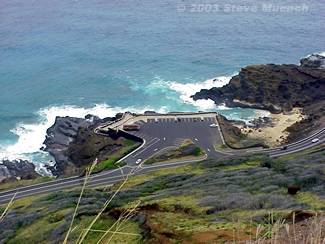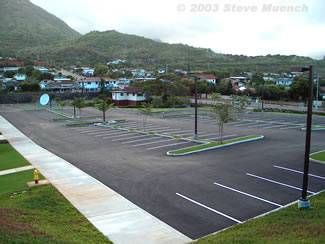Parking Lots
Parking lots are paved areas intended for vehicle parking and can vary widely in size, function and design. This page gives some general guidance when designing at-grade parking lot pavements.
 |
 |
Figure
1: Blowhole parking lot on O'ahu. |
Figure
2: Parking lot in Kailua. |
Assumed Traffic
Low speed automobiles and trucks. Typically, automobiles may
travel anywhere in the parking lot while heavy trucks travel
to and from delivery and pick-up points only. Thus, recommended
parking lot structural design is divided into two categories:
- Light loads. Parking lot areas expected to experience little or no truck traffic can be designed for car and light truck loads only. Typically light load parking lot areas encompass the parking stalls and parking stall access lanes. Truck traffic in these areas is limited to a few medium trucks and the occasional heavy truck that may stray into the parking stall area after hours.
Vehicles per day |
Vehicles per year |
ESALs per year |
|
Cars and Light Trucks |
1,000 |
365,000 |
250 |
Medium Trucks and Buses |
10 |
3,650 |
1,000 |
Heavy Trucks and Buses |
occasional |
10 |
10 |
Totals |
1,010 |
368,660 |
1,260 |
- Heavy loads. Parking areas expected to experience significant truck traffic should include a thicker pavement structure to accommodate these heavier loads. Typically, heavy load parking lot areas encompass the entrance and exit lanes from the parking lot, the area directly in front of a store, truck loading/unloading areas and access routes to these areas. The recommended minimum pavement thicknesses shown here are for typical parking lot heavy load areas. If it is likely a particular parking lot will experience excessive heavy loads, it should be designed using an approved procedure.
Vehicles per day |
Vehicles per year |
ESALs per year |
|
Cars and Light Trucks |
5,000 |
2,000,000 |
1,400 |
Medium Trucks and Buses |
10 |
3,650 |
1,000 |
Heavy Trucks and Buses |
5 |
1,800 |
1,800 |
Totals |
5,015 |
2,005,540 |
4,200 |
Design Considerations
In general, most owners like parking lots to be smooth,
pedestrian friendly and easily maintainable for a minimal
cost. Specific
considerations are:
- Heavy truck traffic. Most parking lots will experience at least some heavy truck traffic related to goods delivery and pick-up. If possible, heavy truck travel should be restricted to designated areas and then only these areas should be designed to accommodate heavy truck loading. Thus, pavements are made thicker where heavy trucks are likely to travel (e.g., to and from the loading dock) and are made thinner where only passenger cars and light trucks are expected (e.g., in the individual parking stalls).
- Design parking lot
geometry to minimize handwork and maximize long straight
paver pulls. Handwork,
the placement
of HMA
by hand shoveling and raking, is more expensive
and results in
a rougher surface texture than pavement placed
by a paver. Although these areas should last
just as long
as the rest
of the parking lot, they often do not look as
good and their roughness
may be unpleasant to walk on or roll a shopping
cart across. In short, the less handwork the
better. Additionally,
the
highest quality pavement is generally placed
by a continuously moving
paver that does not have to repeatedly stop and
start. Specific guidance follows:
- Design parking plans should allow for long, uninterrupted, straight paver pulls. Unusual, non-square geometry and odd-shaped islands make for short paver pulls and create portions of the parking lot inaccessible to the paver that have to be paved by hand.
- Minimize the use of planter islands in the middle of the parking lot. Lots of planter islands result in shorter paver pulls and more paver-inaccessible areas requiring handwork. As an alternative, consider placing planters around the parking lot perimeter or paving the parking lot then sawcutting out areas to be built into planters.
- Drains should follow straight lines so the paver can parallel these lines during laydown. Since only a fixed contour can be laid in one pass of an asphalt paver, designs calling for a meandering gutter or valley require hand placing.
- Drain lines that parallel the long dimension of the parking lot allow for longer paver pulls.

Figure 3: Handwork near the island shows up Rougher than the adjacent surface.
- Drainage. Well-drained parking lots last
significantly longer than poorly drained
parking lots. To
ensure adequate drainage:
- Design parking lots with a minimum slope of 2 percent (0.25 inches per foot). Slopes less than this are difficult to construct and may not prevent pooling of water during wet weather. It is extremely difficult to prevent pooling in parking lots sloped less than 1 percent.
- Where parking lot geometry necessitates hand placed pavement, an increase in minimum slope to 4 percent (0.5 inches per foot) should be considered. Fine grade control is more difficult with hand placement than with machine placement.
- Parking lots placed in cut areas are more susceptible to moisture problems. When placing a parking lot in a large cut area cannot be avoided, take extra care in developing a good drainage plan.
- It is important to maintain adequate drainage during construction and keep water away from the subgrade soil to be paved over. A saturated subgrade soil will be weak and may not adequately support the overlying pavement leading to depressions and fatigue cracking.
- The subgrade should be graded to the final desired parking lot elevation minus the planned pavement thickness. It is difficult to make up grade differences with pavement thickness alone. HDOT specifies that the subgrade should not vary more than 0.05 ft (about 1/2 inch) above or below the theoretical grade.
- Where there is the possibility of recurrent vegetation growth, a quality commercial grade herbicide should be used.
- Parking lots are ideal candidates for site paving in advance of construction.
- Generally, a prime coat underneath a parking lot is not warranted.
Maintenance Considerations
Once completed,
parking lot
pavements can
last a long
time. Generally,
loads are
low so the
primary modes
of deterioration
are subgrade
failures and
aging effects
such as block
cracking and raveling.
- Cracks should be sealed in a timely manner to prevent water infiltration into the subgrade through the cracks.
- A periodic application of a fog seal or slurry seal can prolong parking lot pavement life and improve its appearance.
- Asphalt Institute. Full-Depth Asphalt Pavement for Parking Lots, Service Stations and Driveways, 5th Edition. IS-091. Asphalt Institute. Lexington, KY. (www.asphaltinstitute.org)
- Asphalt Institute. Maintenance and Repair of Asphalt Parking Lots. CL-15. Asphalt Institute. Lexington, KY. (www.asphaltinstitute.org/faq/cl-15.html)
- Asphalt Institute. Model Specifications for Small Paving Jobs. CL-2. Asphalt Institute. Lexington, KY. (www.asphaltinstitute.org/faq/cl-2.html)
Recommended Minimum Pavement Thickness and Design (inches)
HAPI Design Checklist • Standard Hawai'i Mixes • Subgrade • Material Substitutions • ACB
HAPI Design Checklist • Standard Hawai'i Mixes • Subgrade • Material Substitutions • ACB


